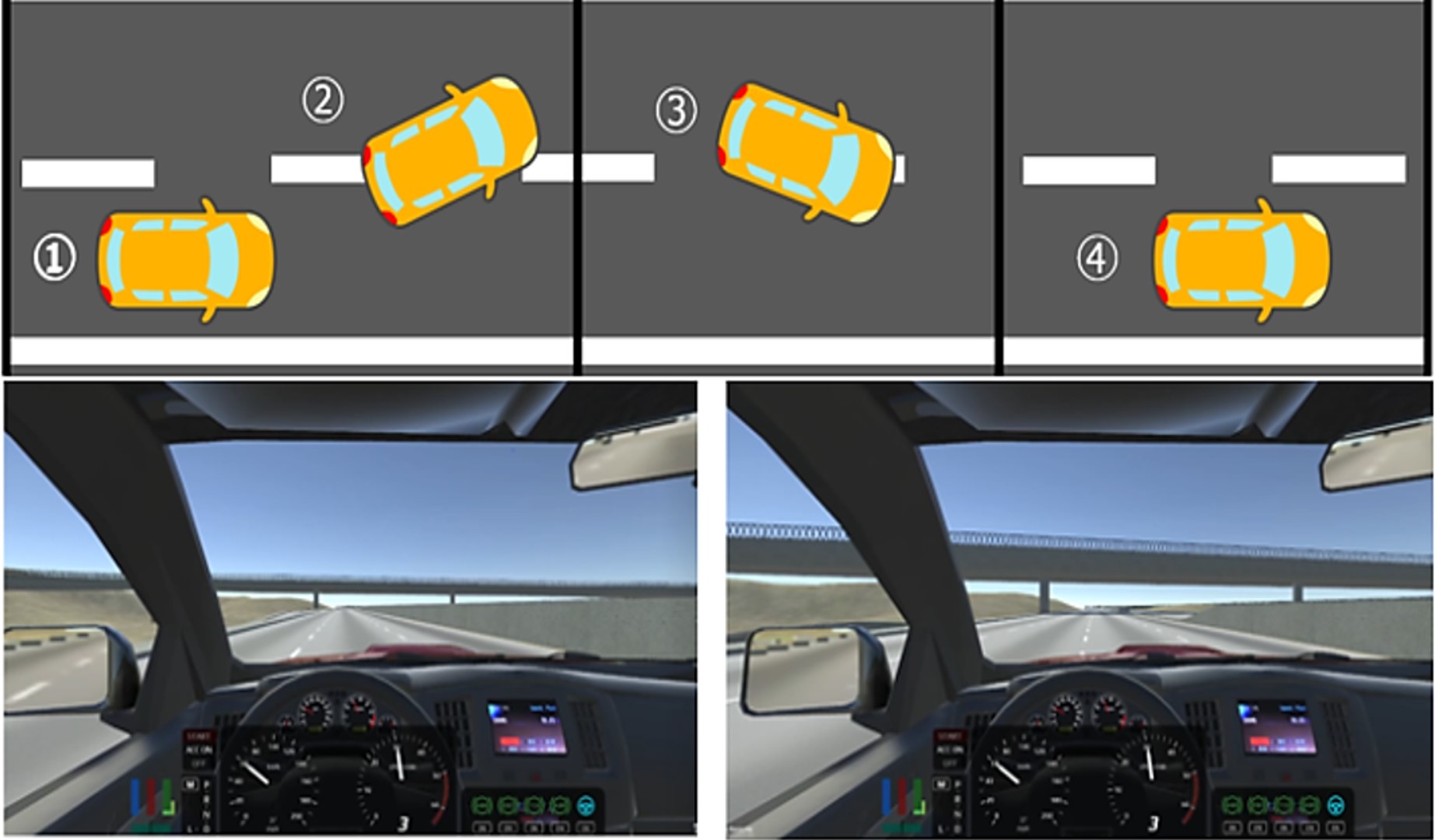Evaluation Methods Using Electrodermal Activity for Interface Design of Autonomous Vehicles
Main Article Content
Abstract
Studies on human behavior in automated vehicles and advanced vehicle control are required as automated driving is expected to become more widespread. For example, Level 2 automated vehicles require constant monitoring to ensure the driver takes appropriate action in an emergency, even when driving hands-free. Constant monitoring will likely lead to stress and mental fatigue in the driver. However, proposing a human interface suitable for automated vehicles may reduce the driver’s mental fatigue. Evaluation methods are crucial for optimal interface development. In this study, we examined the effectiveness of biological responses and a questionnaire to detect the psychological manner in which drivers of automated vehicles use a driving simulator. The measurement results of the subjects mental fatigue obtained using the questionnaire and 0.05 to 0.6 μS as SCR response amplitudes showed that moving up from Level 1 to 2 of automated driving does not necessarily decrease the driver’s mental load.
Article Details

This work is licensed under a Creative Commons Attribution-NonCommercial-ShareAlike 4.0 International License.
This work is licensed under a Creative Commons Attribution-NonCommercial-ShareAlike 4.0 International License.
References
Liu Y, Cui W, Zhou R, Chan AHS. The effects of social conformity and gender on drivers’ behavioural intention towards level-3 automated vehicles. Travel Behav Soc. 2022;29:330-338.
Manawadu UE, Kamezaki M, Ishikawa M, Kawano T, Sugano S. A haptic feedback driver-vehicle interface for controlling lateral and longitudinal motions of autonomous vehicles. 2016 IEEE International Conference on Advanced Intelligent Mechatronics (AIM); 2016 Jul 12-15; Banff, Canada. USA: IEEE; 2016. p. 119-124
Nakayama M, Miura S, Kawano S, Koreeda Y, Yamamoto A, Fukumoto R, et al. Estimation technique of the destined target with gesture recognition for the development of in-car interface of automated driving vehicle. Transactions of the JSME (in Japanese). 2015;81(832):1-17. (In Japanese)
Large DR, Banks V, Burnett G, Margaritis N. Putting the joy in driving: investigating the use of a joystick as an alternative to traditional controls within future autonomous vehicles. The 9th International Conference on Automotive User Interfaces and Interactive Vehicular Applications; 2017 Sep 24-27; Oldenburg, Germany. New York: ACM; 2017. p. 31-39.
Petersen L, Tilbury D, Yang XJ, Robert L. Effects of augmented situational awareness on driver trust in semiautonomous vehicle operation. 2017 NDIA Ground Vehicle Systems Engineering and Technology Symposium; 2017 Aug 8-10; Novi, United State. p. 1-7.
Mok B, Johns M, Yang S, Ju W. Actions speak louder: Effects of a transforming steering wheel on posttransition driver performance. IEEE 20th International Conference on Intelligent Transportation Systems (ITSC); 2017 Oct 16-19; Yokohama, Japan. USA: IEEE; 2017. p. 1-8.
Capallera M, Meteier Q, de Salis E, Angelini L, Carrino S, Khaled OA, et al. Owner manuals review and taxonomy of ADAS limitations in partially automated vehicles. 11th International Conference on Automotive User Interfaces and Interactive Vehicular Applications; 2019 Sep 21-25; Utrecht, Netherlands. New York: ACM; 2019. p. 156-164.
Petersen L, Robert L, Yang XJ, Tilbury DM, et al. Situational awareness, drivers trust in automated driving systems and secondary task performance. arXiv preprint arXiv:1903.05251. 2019:1-26.
Chen W; Sawaragi T, Horiguchi Y. Measurement of driver’s mental workload in partial autonomous driving. IFAC-PapersOnLine. 2019;52(19):347-352.
Walker F, Boelhouwer A, Alkim T, Verwey WB, Martens MH. Changes in Trust after Driving Level 2 Automated Cars. J Adv Transp. 2018;2018:1-9.
Ruijten PAM, Terken JMB, Chandramouli SN. Enhancing trust in autonomous vehicles through intelligent user interfaces that mimic human behavior. Multimodal Technol Interact. 2018;2(4):62.
Detjen H, Pfleging B, Schneegass S. A wizard of oz field study to understand non-driving-related activities, trust, and acceptance of automated vehicles. 12th International Conference on Automotive User Interfaces and Interactive Vehicular Applications; 2020 Sep 21-22; Virtual Event, USA. New York: ACM; 2020. p. 19-29.
Shahrdar S, Park C, Nojoumian M. Human trust measurement using an immersive virtual reality autonomous vehicle simulator. Proceedings of the 2019 AAAI/ACM Conference on AI, Ethics, and Society; 2019 Jan 27-28; Honolulu, USA. New York: ACM; 2019. p. 515-520.
Schwarz C, Gaspar J, Brown T. The effect of reliability on drivers’ trust and behavior in conditional automation. Cogn Tech Work. 2019;21:41-54.
Němcová A, Svozilová V, Bucsuházy K, Smíšek R, Mézl M, Hesko B, et al. Multimodal features for detection of driver stress and fatigue. IEEE Trans Intell Transp Syst. 2020,22(6):3214-3233.
Zontone P, Affanni A, Bernardini R, Piras A, Rinaldo R. Stress detection through electrodermal activity (EDA) and electrocardiogram (ECG) analysis in car drivers. 27th European Signal Processing Conference (EUSIPCO); 2019 Sep 2-6; A Coruna, Spain. USA: IEEE; 2019. p. 1-5.
Morris DM, Erno JM, Pilcher JJ. Electrodermal response and automation trust during simulated self-driving car use. Proc Hum Factors Ergon Soc Annu Meet. 2017;61(1):1759-1762.
Walker F, Wang J, Martens MH, Verwey WB. Gaze behaviour and electrodermal activity: objective measures of drivers’ trust in automated vehicles. Transp Res Part F Traffic Psychol Behav. 2019;64:401-412.
SAE International. Taxonomy and definitions for terms related to driving automation systems for on-road motor vehicles. USA: Society of Automotive Engineers; 2021.
Mok B, Ju W. The push vs pull of information between autonomous cars and human drivers. 6th International Conference on Automotive User Interfaces and Interactive Vehicular Applications; 2014 Sep 17-19; Seattle, USA. New York: ACM; 2014. p. 1-5.
Unity Asset store. Vehicle Physics Pro - Community Edition [Internet]. 2019 [cited 2023 Jan 20]. Available from: https://assetstore.unity.com/packages/tools/physics/vehiclephysics-pro-community-edition-153556?lo cale=ja-JP. (In Japanese).
Fukuda H. How can physiological measurements contribute to Man-Environment research?. MERA J. 2018;41:67-75. (In Japanese)



